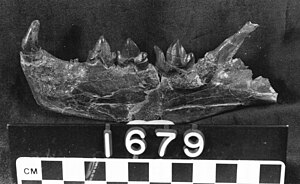Nimravus
| Nimravus | ||||||||||||
|---|---|---|---|---|---|---|---|---|---|---|---|---|

Lower jaw of Nimravus brachyops in the University of California's Museum of Paleontology . |
||||||||||||
| Temporal occurrence | ||||||||||||
| Oligocene | ||||||||||||
| 33.3 to 26.3 million years | ||||||||||||
| Locations | ||||||||||||
| Systematics | ||||||||||||
|
||||||||||||
| Scientific name | ||||||||||||
| Nimravus | ||||||||||||
| Cope , 1879 | ||||||||||||
Nimravus is an extinct genus of roughly leopard-sized, feline predators that wascommon in North America and Europein the early and middle Oligocene . It is the eponymous genus within the Nimravidae family. In contrast to other Nimravids such as Eusmilus , the upper canine teeth were less enlarged and only reached a relative size similar to that of today's big cats .
A number of well-preserved skulls of the type species Nimravus brachyops have been found in the US states of Oregon , Nebraska, and South Dakota . The skull is very similar to cats and presumably the representatives of the genus looked much closer to today's cats than some of their direct ancestors. Other features of the skull such as the shape of the teeth and the ear region clearly show the typical characteristics of the Nimravids. Little is known about the postcranial skeleton. However, it appears that the thigh and foot bones were much slimmer than those of other Nimravids of the Oligocene.
species
- Nimravus brachyops ( Cope , 1878) - North America
- Nimravus sectator Matthew , 1907 - North America
- Nimravus intermedius ( Filhol , 1872) - Europe
literature
- A. Turner, M. Antón: The big cats and their fossil relatives. Columbia University Press, New York NY 1997, ISBN 0-231-10229-1 .
- Jordi Augusti, Mauricio Antón: Mammoths, Sabertooths, and Hominids. 65 Million Years of Mammalian Evolution in Europe. Columbia University Press, New York NY et al. 2002, ISBN 0-231-11640-3 .
- Donald R. Prothero, Robert J. Emry (Eds.): The Terrestrial Eocene-Oligocene Transition in North America. Cambridge University Press, New York NY et al. 1996, ISBN 0-521-43387-8 .